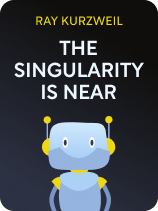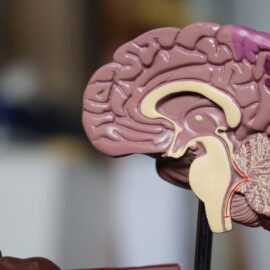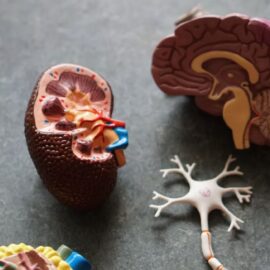

This article is an excerpt from the Shortform book guide to "The Singularity Is Near" by Ray Kurzweil. Shortform has the world's best summaries and analyses of books you should be reading.
Like this article? Sign up for a free trial here.
What is the technological Singularity? What’s the Catch-22 about our ability to understand it?
According to computer scientist Ray Kurzweil, the Singularity of technology could lead to a future in which we use genetics to reprogram the body, we have the power to digitally augment our brains, and we even live forever. He explains this exponential progress in The Singularity Is Near.
Keep reading to understand this profound technological shift that could change everything.
What Is the Technological Singularity?
What is the technological Singularity? According to Ray Kurzweil, the Singularity is a phase in which technology changes so fast that it’s impossible to know what’s on the other side. He explains that, not only is the rate of technological progress increasing, but the rate at which that rate is increasing is also accelerating.
We’ll begin by looking at where the “singularity” concept comes from, how Kurzweil came to apply it to the process of technological advancement, and his thoughts on what it might mean for human life once technological intelligence outstrips our own.
In mathematics, a singularity is the result of an equation that produces exponential numbers flying off into infinity. In astronomy, the word “singularity” refers to the center of black holes, where matter and energy are compressed to infinite density. When Kurzweil uses the term in his projections of the future, he’s referring to a point in the future when technological progress will be so great that it will appear infinite for all practical purposes. Nevertheless, Kurzweil points out that, because the technological Singularity will include enhancements to human intelligence, we’ll be better equipped to understand it when it comes than we are in the present moment.
(Shortform note: The concept of a mathematical singularity was introduced by the British mathematician Andrew Russel Forsyth in his 1893 book Theory of Functions of a Complex Variable. When singularities appear in mathematical functions that are meant to describe real-world phenomena, scientists normally take it to mean that the mathematical model is somehow in error. While black holes presumably provide examples of singularities in the real world, physicist Michio Kaku suggests that instead of singularities, black holes may hide gateways into other dimensions, sometimes known as Einstein-Rosen bridges. The question of whether mathematical singularities have any meaning in the physical universe is still open.)
Into the Future
For now, we have to use our imagination to picture a world with such dramatic rates of change. Kurzweil started doing so as he worked in the computer industry during the 1970s. While mapping the rate of technological progress so he could guess the best time to bring products to market, he saw that the path of technology’s advancement takes the shape of an exponential curve, with a flash of mind-boggling advancement due to arrive in the 2030s and ’40s.
(Shortform note: Kurzweil, a computer engineer, conducted his early work in the field of pattern recognition, the process of programming machines to identify patterns in information and apply meaning to the data—something that human brains do with ease. One of Kurzweil’s early inventions was a reading machine that could scan a page of printed text, identify letters and words in the image, and output the text as synthesized speech. Introduced in the 1970s, Kurzweil’s advances in pattern recognition are still in use as a reading aid for people with vision impairments as well as a means to scan printed text into electronic databases.)
Kurzweil says that a key feature of this rapid growth will be the use of machines to augment human intelligence. We’ve already been doing this for decades. But, as we approach the technological Singularity, the intellectual “center” of the human race will shift from our brains to the digital world, perhaps even going so far as to upload human consciousness into the digital realm. To some, this may be frightening, but Kurzweil believes the transition will be consensual and gradual. Whatever intelligence comes “after” us will be produced by and modeled on human consciousness and thought. No matter what form our future selves take, the information that constitutes our minds, personalities, and underlying humanity will continue uninterrupted.
(Shortform note: Kurzweil presents artificial intelligence (AI) augmentation as a continuum from relieving people of cognitive drudgery to directly advancing the human brain itself, but two decades after his book’s publication, AI is still primarily used to perform tasks that humans once did. One example is in the field of job recruitment, where a growing number of companies are using AI to screen potential candidates before they’re even considered by a real person. Critics argue that ceding human intellectual work to unconscious algorithms opens the door to automated judgments made without taking ethics, moral values, or other intangible human factors into account.)
Exponential Progress
Kurzweil’s predictions may seem like science fiction, but he grounds them in an analysis of ongoing trends in technological advancement. These trends suggest that our capabilities as a species are increasing at an exponential rate. We’ll explain what exponential growth means in practice, how it applies to technological development, and what Kurzweil sees as exponential advancement in parts of human society beyond what’s governed by mere machines.
When we say that something’s growth is exponential, we mean that it increases by multiplication rather than by addition, as is the case with linear growth.
Kurzweil applies this same principle when charting the progress of technological innovations. Each advancement multiplies the power of what came before, in turn fostering and speeding up the next round of innovations.
When applied to technology, exponential trends may be hard to spot in the short term, but when you look at long-term progress, the evidence is compelling.
The Pattern of Change
Kurzweil explains that these advancements go in phases. As every new technology is introduced, it catches on slowly as its kinks are worked out. Following this is a burst of rapid growth as the technology is accepted and spreads throughout society. Once a technology has spread and matured, advancement within it seems to slow down, but this pause is just an illusion. Once a technology hits its “plateau,” its limitations become apparent and work begins on the next innovation that will replace it and propel the next paradigm, just as cell phones have replaced landlines. Kurzweil’s point is that these technological changes are happening faster and faster—years instead of decades, decades instead of centuries.
Kurzweil also argues that the coming tectonic shifts in society won’t be due to growth in one field of human endeavor but in every aspect of society all at once. These include accelerating economic growth, especially in the developing world, an exponential increase in the availability of education worldwide, and the rapidly multiplying power of computing available in cheaper and faster devices as measured by the amount of computation per dollar. Writing in 2005, Kurzweil predicted that all these forces would result in a dramatic decrease in global poverty coupled with personal computers running at near-human brain capacity by the 2020s. However, every field of advancement brings with it a new host of problems and concerns.

———End of Preview———
Like what you just read? Read the rest of the world's best book summary and analysis of Ray Kurzweil's "The Singularity Is Near" at Shortform.
Here's what you'll find in our full The Singularity Is Near summary:
- The upcoming technological shift that will change everything
- The revolutions in bioscience, nanotechnology, and artificial intelligence
- How Kurzweil's predictions held up over time






